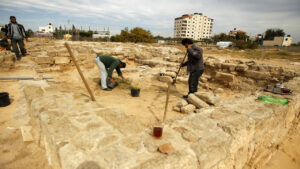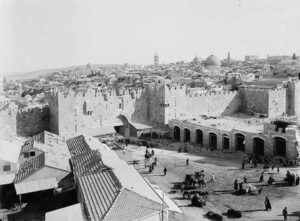The Early History of Palestine and How It Got Its Names: The olive tree is a powerful symbol across the Middle East and Mediterranean. It was sacred to Isis for Egyptians, called “liquid gold” by Greeks in the Iliad, and a symbol of peace in Psalms for Jews. Christians associate it with Gethsemane, where Christ prayed, and Muslims link olives to Muhammad.
The Early History of Palestine and How It Got Its Names
Cultivated as early as the 8th millennium BCE in the Levant, this land has been known as Canaan, Eretz Yisrael, and Palestine.
Contrary to misconceptions, “Palestine” appears in ancient texts, like those of Herodotus. In this episode, we will investigate how Palestine got its name, as well as discuss its vibrant and diverse history, from the Neolithic to the Roman Period. Welcome to our video on the history and name of Palestine.
Where Does the Name Come From?
Before we jump into the history of Palestine, we should first discuss the history of the name itself. The word ‘Palestine’ is often assumed to come from Syria Palestina, the name that Emperor Hadrian gave to the Roman Province of Judea after putting down the Great Jewish Revolt of 66 AD. However, the name Palestine, much like the olive tree, has far deeper roots.
The word first appears in the writings of the Greek Historian Herodotus, who predated the rise of Rome by several centuries. However, the origin of the name ‘Palestine’ may predate even the father of history himself. The early history of Palestine is marked by numerous civilizations that contributed to its rich cultural heritage.
It likely comes from one of the tribes of Sea Peoples as far back as the Late Bronze Age called the Peleset, who appear under the same name in both Ancient Mesopotamian and Egyptian sources. In short, the name ‘Palestine’, when used to refer to both a place and a people, is millennia older than its supposed Roman origin.
Of course, the land of Palestine has had many other names throughout history, while the territorial boundaries of what constitutes Palestine have fluctuated over the centuries. The early history of Palestine dates back thousands of years, with evidence of ancient settlements along the Mediterranean coast.
Eretz Yisrael, or Land of Israel, is a name that appears in Biblical sources, and its boundaries also vary to include parts of Lebanon and Syria, but exclude parts of southern Palestine, which the Bible calls the Land of Edom.
The Holy Land, meanwhile, is a mostly Christian name that appeared in the Middle Ages and refers primarily to Jerusalem and other sites in the Levant considered holy to Christianity. Archaeological discoveries in the early history of Palestine reveal a mixture of Egyptian, Canaanite, and other ancient influences.
The name Canaan broadly refers to the southern Levant, and is also present in Biblical texts. The historical Kingdoms of Israel and Judah ruled parts of this territory, but never reigned over all of Canaan or the Promised Land. The early history of Palestine saw the rise of the Israelites, who established a kingdom in the region.
Throughout the ages, the boundaries of what people consider to be Israel, Palestine, Canaan, Judea and the Holy Land have shifted to sometimes include various parts of modern Israel/Palestine, and contract or expand beyond them at other times.
The Eastern Roman Empire, which survived into the middle ages after the fall of its Western counterpart, also had three separate provinces called Palestina Prima, Palestina Secunda, and Palestina Salutaris controlling the local territories from Constantine’s reign to the Arab Conquest with a brief Sasanian interregnum in the 610s.
Over the centuries, the name ‘Palestine’ has undergone surges of popularity among the people who lived in the southern Levant, but has always co-existed with myriad other identities, both geographical and cultural.
Having covered that, let us now step back into the obscure mists of prehistory, and begin our recounting of the history of Palestine from the very beginning. The early history of Palestine is deeply intertwined with religious significance for Judaism, Christianity, and Islam.
The Early History of Palestine and Neolithic Palestine
We will begin our whistle-stop tour of Palestinian history in the Neolithic stone age, during which agricultural societies were already forming along the Levantine coast. By the time we get to the Bronze Age, these agricultural settlements increased in size, and Palestine entered a long period of contact with the Eastern Mediterranean.
Palestine, or Canaan during the Bronze Age was mostly a clan-based society, a collection of urban and rural settlements decorating the rich countryside. In the early history of Palestine, the region was often a crossroads for trade and conquest due to its strategic location.
These would eventually develop into the various kingdoms made known to us from Biblical sources, such as Moab, Edom, Israel, and Judah. The most likely religious composition at the time was a broader Semitic polytheism, much like their cousins to the north who would become the Phoenicians.
In fact, the interplay of this common religious milieu appears in how the storm God Ba’al, a popular Phoenician deity, influenced later deities like El and Yahweh, whose hybridization led to the God of the Hebrew Bible. Like any land that straddles the crossroads between Empires, Canaan was caught in the geopolitics of the giants of the period.
Throughout the Bronze Age, Ancient Egypt would prove to be a steady influence on the broader Near East, while Canaanite cities continued to trade with both Egypt and Ancient Mesopotamia as the trade networks of the epoch continued to grow.
The Late Bronze Age
As the late Bronze Age dawned in the 1500s BCE, the Sun God of the Egyptians Ra, wrestled in the sky with the Storm God of the Hittites, Tarhunna, for control of the Lands of the Gods Yahweh and El. Canaan was one of the battlegrounds between the mighty Hittite and Egyptian Empires during this period, and eventually came under the control of the Egyptians.
The Egyptians left a physical mark on the region, appearing to have built various administrative complexes throughout Canaan. Under Egyptian rule, local Canaanite clan structures survived, although the local culture infused itself with Egyptian culture.
This form of cultural entanglement was common throughout the Late Bronze Age; the Canaanite populations during this time appear to have worshipped a mixture of Egyptian and local deities, such as in the Fosse Temple in Tel Lachish, where a local proto-cult was mixed with a cult of the Egyptian Goddess Hathor.
The end of the Bronze Age in the 1200s BCE and the various turbulences that ensued were significant turning points for the region. It is during this period that a name approximating Palestine appears, possibly through a tribe of the so-called Sea Peoples called the Peleset.
The Peleset may have come from Greece, but this is far from confirmed, and their name first appears in regional Egyptian records. The early history of Palestine includes periods of Egyptian rule, followed by the establishment of the Kingdom of Israel and Judah.
The Sea Peoples are often claimed to have been one of the causes of the end of the Bronze Age through their mass raids. However, the paradigm of mass invasions and migrations has been questioned by scholars, as well as the notion that these were one cohesive ethnic group, and it is also probable that a lot of cultural mixture took place between new arrivals and existing populations.
While we have some evidence of social disruption, it is best to see Palestine as undergoing a period of transition into the more decentralized Iron Age. The early history of Palestine was also shaped by the influence of the Phoenicians, who were renowned for their maritime trade.
The Early Iron Age
Throughout the Iron Age, the land of Palestine was a diverse tapestry of many cultures. It was also an era of political consolidation, when Kingdoms began to appear along the coast and in the hinterlands. In the region of Pentapolis straddling the coast, a confederation of five primarily Philistine cities formed.
In the south, the Kingdom of Edom reigned over what is today the Negev desert, while in the east, the Kingdom of Moab reigned over the east bank of the Jordan. Throughout the early history of Palestine, the land was controlled by various empires, including the Romans and the Byzantines.
In 1208 BCE, the first mention of Israelites as a people outside of the Hebrew Bible appears in the Merneptah Stele. It is also during this period that Biblical accounts begin to definitively correspond to the events of history.
In the central hinterlands and the north, the Kingdom of Judah and Kingdom of Israel were formed from the consolidation of tribal clans.
The Biblical King of Israel, David, is likely a real historical figure from the 9th Century BCE as archaeologists have discovered records in the land of the historical Kingdom of Israel a few decades after his reign mentioning him by name.
Religious life across the Levantine realms during this time was in a period transition, as rituals like keeping Kosher appeared, but polytheism remained the norm in most Kingdoms.
Canaanite polytheism was similar to the religion of the Phoenicians, for they were related peoples whose languages both belonged to the Semitic tree. However, Phoenician and Canaanite religion had regional differences.
What we can tell is that as the Kingdoms consolidated, a single God would emerge from their polytheistic pantheons as the chief and patron God of their Kingdom. It is here that the first Temple of Judaism appeared in Jerusalem, a religious complex devoted to Yahweh, the Patron God of Israel.
First Temple Judaism was very different from later Judaism. The Jewish people during this period were monolatric, meaning they believed in other Gods, but put a specific and singular devotion in their worship of YAHWEH.
The various Kingdoms of the region traded and warred with each other as often as the rest of their neighbours throughout the expanses of the Mediterranean did. In fact, the two Kingdoms of Israel and Judah were most likely one Kingdom that split into two sometime in the 10th Century CE due to internecine strife.
However, recent scholarly debates consider the opposite to have been the case; with the two Kingdoms merging at some point during the reigns of Kings Josiah and Hezekiah, though we are unsure of when exactly this occurred.
The Late Iron Age
As the early iron age transitioned into the late iron age, the Kingdoms of Palestine fought one another as around them, Empires began to form. During this era, Biblical sources become more useful as a historical primary source, with the Kingdom of Judah taking centre stage on its pages. A palaeo-Hebrew writing system; based on the Phoenician alphabet, also begins to appear during this period.
Pentapolis, Moab, and Edom also continued to exist and interact with both the Kingdoms of Israel and Judah. It is here that Biblical stories like those of Josiah, the King who probably initiated the shift towards Monotheism in Judaism, and Hezekiah, the king who withstood a siege by the Assyrian King Sennacherib, come into the fore.
However, we must bear in mind that some of these Biblical Books were written centuries after both Josiah and Hezekiah’s reigns.
With that said, the historical legacy of these legendary Jewish Kings are sometimes evident in the archaeological record, such as in the cisterns underneath Jerusalem, which were built during Hezekiah’s reign.
Eventually, the heyday of the Hebrew Kingdoms came to an end when the armies of Marduk began to march from Babylonia. Sweeping into the Levant, the Babylonian Empire descended down from Syria and destroyed the Kingdom of Israel in around 720 BCE.
Judah survived for two more centuries until 587 BCE when it too was destroyed and the First Temple in Jerusalem is said to have been ruined. Other local Canaanite kingdoms were annexed by the Babylonians as well.
For Judaism, this is the start of the Babylonian Exile, where Biblical sources claim the Jewish people were expelled from Palestine to Babylon. However, it should be noted that it was the elites who mostly were exiled to Babylon.
This would prove a seminal turning point in the history of Judaism, turning it from a regional sect with a backbone in local Canaanite religious ideals, to one influenced by Canaanite, Babylonian, and eventually even Iranian sources. you can read more about The Early History of Palestine here and here.


